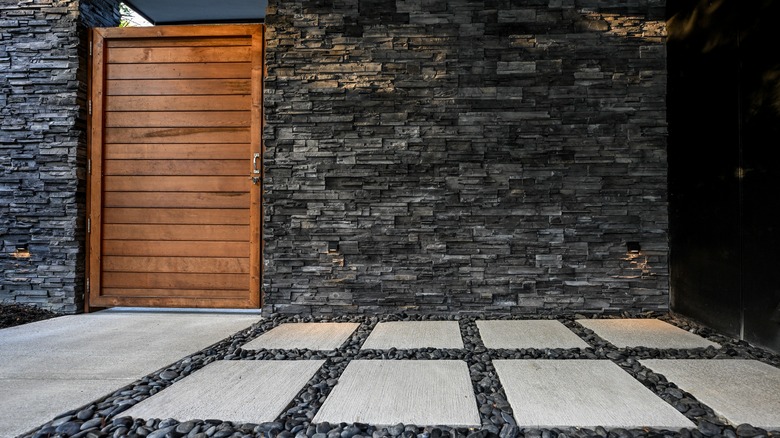Forget Expensive Materials Or Paving And Consider A Paver Pathway Patio Instead
You have to be super creative to invent a budget-friendly patio addition that livens up a bare outdoor living space, right? Actually, with a relatively small amount of spare cash, some tools you already have, and a bit of hard graft (yup, this is do-able by your lonesome ol' self), a new patio doesn't have to cost the earth — though, since it's made from permeable materials, it is earth-friendly. Enter the paver pathway patio! What is that, you ask? Picture a flagstone and gravel pathway meandering through a quaint cottage garden or a river stone and geometric cement paver walkway cutting through a dramatic contemporary backyard. Then extrapolate that out to encompass the space a typical patio would take up.
A professionally made paver pathway patio could cost up to $50 a square foot. DIY-ing it is kinder on your backyard renovation budget. To keep costs low, stick with basic square concrete pavers in a hue that complements your current outdoor decor. Lowe's sells 12 x 12-inch square concrete patio stones in gray, red, white, and tan for under $5 each. Willing to invest a little more in something natural? Portland Rock & Landscape Supply sells gold quartzite flagstones with silver accents for $460 per ton, not including delivery costs. If you have time on your hands to wait for true bargains to pop up on Facebook marketplace, you can mix pavers of different sizes and materials together to create an eclectic aesthetic. Or, just as a Buy Nothing group is the perfect way to furnish your home on a budget, it is also a great option for potentially finding stray pavers.
Ready for budget backyard relaxation? DIY your paver pathway patio
Gravel, especially pea gravel, is surprisingly affordable — a 1/2 cubic foot bag of pea gravel is just over $4 from Menards. If you're willing to spend a bit for more style, Mulch & Stone sells 1 to 3-inch-size decorative river rock for $350 a ton. Use HomeAdvisor's gravel calculator to work out how much you'll need. Note that it may need a wash once it arrives. Tools-wise, you'll need string and stakes for mapping out the working area, a shovel, and a dirt tamper or compactor. If you ordered bulk loose gravel, you might also need a wheelbarrow. Weather-proof timber planks cut to length in advance or other edging materials for a frame and landscaping fabric (a weed deterrent) are optional but recommended for a neater finish.
First, get designing your perfect patio digitally or on paper; consider everything from the outside dimensions to how you'll arrange your stones. A solid plan will help you determine how much of all the different materials you'll need. Use string to mark out the patio border and dig down into the ground to a depth that matches the width of the pavers. A firm base is essential for a level, trip-safe paver pathway patio; use your dirt tamper or vibrating plate compactor (you can rent one) to create a flat surface, then lay your landscaping fabric, if you're using it. Atop that, place your edging material (again, if you're using that) and your pavers, following your plan regarding design. Pour over the gravel into the gaps between the pavers, packing it in tightly with your hands.
